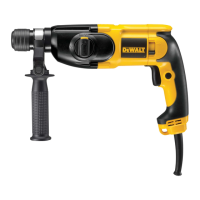9
English
DRILLING IN METAL
An SDS Plus
®
to round shank adaptor chuck is required. Ensure that
tool is in drill-only mode. Start drilling with slow speed and increase to
full power while applying firm pressure on the tool. A smooth even flow
of metal chips indicates the proper drilling rate. Use a cutting lubricant
when drilling metals. The exceptions are cast iron and brass which
should be drilled dry.
NOTE: Large [5/16" to 1/2" (7.9 mm to 12.7 mm)] holes in steel can
be made easier if a pilot hole [5/32" to 3/16" (4 mm to 4.8 mm)] is
drilled first.
DRILLING IN WOOD
An SDS Plus
®
to round shank adaptor chuck is required. Ensure that
tool is in drill-only mode. Start drilling with slow speed and increase
to full power while applying firm pressure on the tool. Holes in wood
can be made with the same twist drills used for metal. These bits may
overheat unless pulled out frequently to clear chips from the flutes. For
larger holes, use spade bits, power auger bits, or hole saws. Work that
is apt to splinter should be backed up with a block of wood.
HAMMERDRILL OPERATION
1. When drilling, use just enough force on the hammer to keep it from
bouncing excessively or “rising” off the bit. Too much force will
cause slower drilling speeds, overheating, and a lower drilling rate.
2. Drill straight, keeping the bit at a right angle to the work. Do not
exert side pressure on the bit when drilling as this will cause
clogging of the bit flutes and a slower drilling speed.
3. When drilling deep holes, if the hammer speed starts to drop off,
pull the bit partially out of the hole with the tool still running to help
clear debris from the hole.
4. For masonry, use carbide-tipped bits or masonry bits. A smooth
even flow of dust indicates the proper drilling rate.
Press mode selector button (F) and turn the mode selector (G) to the
drill bit symbol for drilling, to the hammer symbol for hammering or to
the hammerdrill symbol for hammerdrilling.
DRILLING OPERATION
1. For WOOD, use twist bits, spade bits, power auger bits or hole
saws. For METAL, use high-speed steel twist drill bits or hole saws.
Use a cutting lubricant when drilling metals. The exceptions are
cast iron and brass which should be drilled dry. For MASONRY,
use carbide-tipped bits or masonry bits. A smooth, even flow of
dust indicates the proper drilling rate.
2. Always apply pressure in a straight line with the bit. Use enough
pressure to keep the drill bit biting, but do not push hard enough
to stall the motor or deflect the bit.
3. Hold tool firmly with both hands to control the twisting action of the
drill.
WARNING: Drill may stall if overloaded causing a sudden twist.
Always expect the stall. Grip the drill firmly with both hands to control
the twisting action and avoid injury.
4. IF DRILL STALLS, it is usually because it is being overloaded.
RELEASE TRIGGER IMMEDIATELY, remove drill bit from
work, and determine cause of stalling. DO NOT CLICK
TRIGGER OFF AND ON IN AN ATTEMPT TO START A
STALLED DRILL – THIS CAN DAMAGE THE DRILL.
5. To minimize stalling or breaking through the material, reduce
pressure on drill and ease the bit through the last fractional part of
the hole.
6. Keep the motor running when pulling the bit back out of a drilled
hole. This will help prevent jamming.
7. With variable speed drills there is no need to center punch
the point to be drilled. Use a slow speed to start the hole and
accelerate by squeezing the trigger harder when the hole is deep
enough to drill without the bit skipping out.

